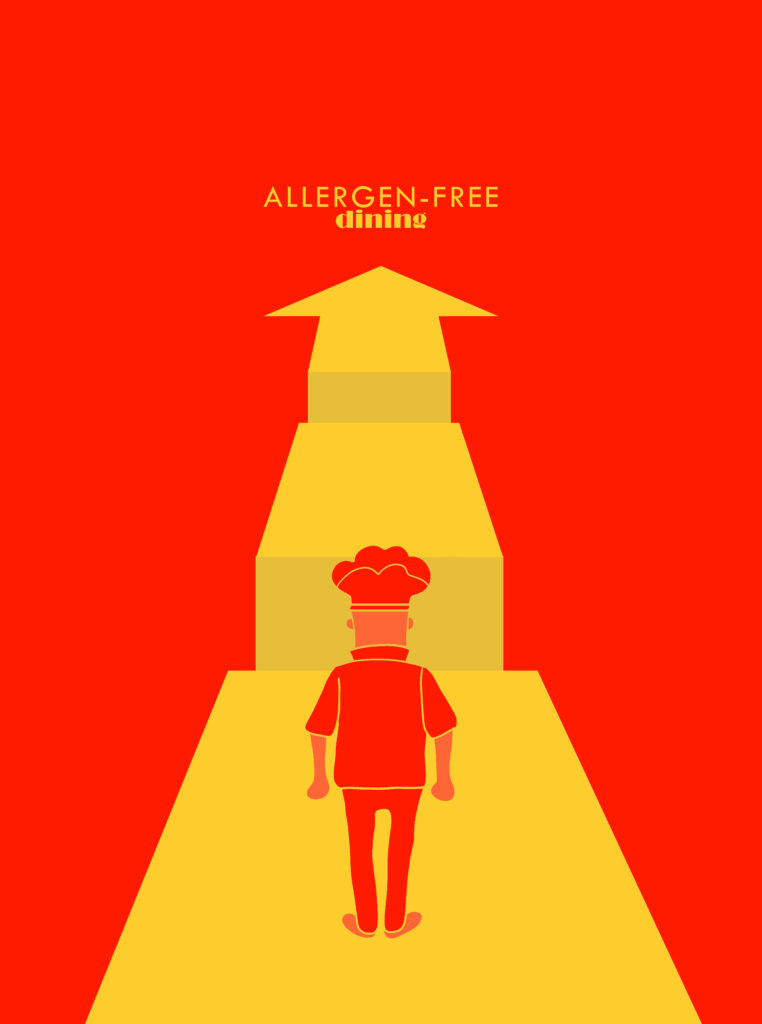Vision

I believe people with food allergies should be able to eat out without stress and anxiety about an allergic reaction. Inclusive Gastronomy Design is about how technologies, such as 3D food printing, can provide a more inclusive experience for people with food allergies. Namely, when eating out, they try to prevent an allergic reaction by avoiding strategies: controlling allergens intake and reading food labels [1,2]. I think communication, trust, and information about allergens are essential to work towards an ideal situation where people with a food allergy can comfortably participate in a dinner event. To improve this on a large scale, there is a need for standardization in handling food allergies, such as an unambiguous use of allergen icons.
Trust is an essential aspect of Inclusive Gastronomy Design, and I believe a 3D food printer can help gain certainty by showcasing transparent and isolated preparation. Additionally, 3D printing for food allergies can add new value by creating allergen-free alternatives of equal quality. Food designers should understand that substitutes can create new taste sensations, old taste sensations, and aversion. Credibility and trust can contribute to not being afraid of the taste but the allergen they are ingesting.
Professional Identity
I am Jillian de Bie, an EngD candidate in the Department of Industrial Design at the Eindhoven University of Technology. During my master’s program, I developed myself within the Design, Leadership, and Entrepreneurship track, specializing in the expertise areas of Creativity & Aesthetics and User & Society.
Based on previous work experiences, I prefer freedom and the chance to experiment with materials/design and interact socially with colleagues or users. Due to my youthful, enthusiastic, and curious disposition, I enjoy experimenting and exploring. In addition, I enjoy designing for social activities, where people forget time and enjoy the moment. Therefore, I want to create positive experiences and memories through design.
After my bachelor, I was familiar with the goal-oriented way of working and linear design processes. This changed when I moved to my focus on food with explorative design processes and research through design. I learned to work from a material perspective with broad explorations and combined with user perspectives, it generates ideas and solutions to undefined problems for me.
I control progress, challenge myself, and switch between diverse project activities. Since I like to travel, new people and places inspire my creativity. One of my strengths is that I am so enthusiastic about projects that I always keep them in my mind. As a result, I often discuss with different people about the complexity in an informal setting; talking and reflecting from different perspectives help me find connections between different problems. Afterward, I use this inspiration when brainstorming new directions, as I did in my graduation project.
3D Food Design projects from Margarita Kuzina [3] and Elzelinde van Doleweerd [4] inspired me to work on food projects. However, it was naive to assume that I could do this with my severe tree nut allergy. Instead, I decided to use this personal aspect for my future designs, and I have very high intrinsic motivation for this subject. After all, many different interests come together in human food interaction, namely technology, behavior, food, experimentation, user testing, social problems, and a variety of users.
While Food allergies are a common health disease, not many people know that the quality of life of someone with food allergies is lower than someone with diabetes [5]. It is, therefore, essential to focus on integrating and empathizing with the perspective of the user and society since the impact of having a food allergy is enormous. It is, therefore, necessary to have a distinct understanding of the extent of food allergies when designing for it. I will need to develop my competencies in food allergies further to cope with other problems and incorporate other food allergies in my designs. My current projects have mainly focused on 3D printing, restaurant experience, gastronomy, and tree nut allergy.
Since my M1.2 research project, the focus of my study has been on developing four core competencies, namely the knowledge and expertise to describe the context, delving into allergens and allergic reactions, understanding the value and business angle of 3D printing in Inclusive Gastronomy Design, and searching for solutions.
Learn more about my growth as a designer





References:
[1] Feng, C., & Kim, J. H. (2019). Beyond avoidance: the psychosocial impact of food allergies. Clinical reviews in allergy & immunology, 57(1), 74-82.
[2] Leftwich, J., Barnett, J., Muncer, K., Shepherd, R., Raats, M. M., Hazel Gowland, M. & Lucas, J. S. (2010). The challenges for nut-allergic consumers of eating out. Clinical & Experimental Allergy, 41(2), 243–249. https://doi.org/10.1111/j.1365-2222.2010.03649.
[3] Food Innovation | Margaritak. (n.d.). MK. Retrieved January 19, 2023, from https://www.margaritak.com/
[4] Elzelinde van Doleweerd. (n.d.). Instagram Retrieved January 19, 2023, from https://www.instagram.com/_elzelinde/
[5] Knulst, A. C. (2018, April). Muziek in de allergologie. Nederlands Tijdschrift Voor Dermatologie En Venereologie, 28(4). Retrieved March 29, 2022, from https://nvdv.nl/storage/app/media/muziek-in-deallergologie-ac-knulst-ntvdv-2018-04.pdf